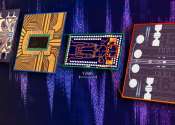With a zap of light, system switches objects' colors and patterns
When was the last time you repainted your car? Redesigned your coffee mug collection? Gave your shoes a colorful facelift?
May 4, 2021
1
67
Engineering

When was the last time you repainted your car? Redesigned your coffee mug collection? Gave your shoes a colorful facelift?
May 4, 2021
1
67
Computer Sciences

Researchers have developed a brain-like computing device that is capable of learning by association.
Apr 30, 2021
2
384
Computer Sciences

With a simple artificial nervous system now able to mimic human responses to light, scientists are learning more about how to program such technology for use in medical robotic prostheses.
Engineering

Inspired by the eyes of mantis shrimp, researchers have developed a new kind of optical sensor that is small enough to fit on a smartphone but is capable of hyperspectral and polarimetric imaging.
Mar 3, 2021
0
109
Robotics

Schools of fish exhibit complex, synchronized behaviors that help them find food, migrate and evade predators. No one fish or team of fish coordinates these movements nor do fish communicate with each other about what to ...
Jan 13, 2021
0
121
Engineering

By expanding on existing designs for electrodes of ultra-thin solar panels, Stanford researchers and collaborators in Korea have developed a new architecture for OLED—organic light-emitting diode—displays that could enable ...
Oct 22, 2020
0
200
Consumer & Gadgets

A Chinese multinational electronics company has developed a new type of screen technology that provides sharper graphics than traditional E Ink displays, with less power consumption, no backlight and an ability to display ...
Engineering

In a step closer to skyscrapers that serve as power sources, a team led by University of Michigan researchers has set a new efficiency record for color-neutral, transparent solar cells.
Aug 17, 2020
2
3272
Engineering

"For the first time ever, we have direct experimental evidence that an external quantum efficiency above 100% is possible in a single photodiode without any external antireflection," says Hele Savin, associate professor of ...
Electronics & Semiconductors

Researchers from ETH Zurich have achieved what scientists have been attempting to do for some 20 years: in their laboratory work as part of European Horizon 2020 research projects, they have manufactured a chip on which fast ...
Jul 3, 2020
2
2490
Light is electromagnetic radiation, particularly radiation of a wavelength that is visible to the human eye (about 400–700 nm, or perhaps 380–750 nm.) In physics, the term light sometimes refers to electromagnetic radiation of any wavelength, whether visible or not.
Three primary properties of light are:
Light, which exists in tiny "packets" called photons, exhibits properties of both waves and particles. This property is referred to as the wave–particle duality. The study of light, known as optics, is an important research area in modern physics.
This text uses material from Wikipedia, licensed under CC BY-SA